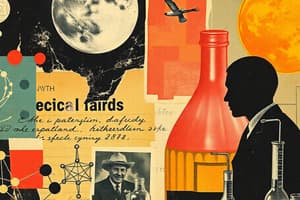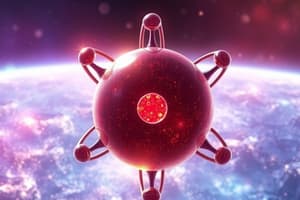Podcast
Questions and Answers
What did Democritus theorize in 450 BCE?
What did Democritus theorize in 450 BCE?
the existence of atoms in the void
What accurate measurements did Antoine Lavoisier theorize in the 1780s?
What accurate measurements did Antoine Lavoisier theorize in the 1780s?
the composition of chemical compounds and that compounds containing more than one element always had the same relative amounts of each element
What was John Dalton's discovery about matter?
What was John Dalton's discovery about matter?
Matter is divisible but not infinitely divisible; the smallest unit he named atom.
What does H₂O represent in chemistry?
What does H₂O represent in chemistry?
What does CO₂ represent in chemistry?
What does CO₂ represent in chemistry?
What does CH₄ represent?
What does CH₄ represent?
What formula represents acetic acid?
What formula represents acetic acid?
CH₃CH₂CH₃ is a chemical formula for ______.
CH₃CH₂CH₃ is a chemical formula for ______.
What does the atomic mass of Nitrogen ⁷N refer to?
What does the atomic mass of Nitrogen ⁷N refer to?
What is the significance of the atomic number?
What is the significance of the atomic number?
How can you calculate the number of neutrons using the atomic number and the mass number?
How can you calculate the number of neutrons using the atomic number and the mass number?
What is conventional representation in terms of an atom?
What is conventional representation in terms of an atom?
What did Rutherford's gold foil model lead to the discovery of?
What did Rutherford's gold foil model lead to the discovery of?
What did Thomson's Plum Pudding Model suggest?
What did Thomson's Plum Pudding Model suggest?
What is the formula for calculating the mass number?
What is the formula for calculating the mass number?
What is an isotope?
What is an isotope?
What happens when you decrease or increase the number of neutrons in an atom?
What happens when you decrease or increase the number of neutrons in an atom?
What is used to identify an element?
What is used to identify an element?
What is the pattern in each group of the periodic table?
What is the pattern in each group of the periodic table?
How do atoms form ions?
How do atoms form ions?
Why will atoms form ions?
Why will atoms form ions?
Study Notes
Historical Theories and Discoveries
- Democritus theorized in 450 BCE the existence of atoms in a void.
- Antoine Lavoisier in the 1780s emphasized accurate measurements in chemical compounds, establishing that compounds with multiple elements consistently maintain the same relative amounts of each.
- John Dalton discovered that matter is not infinitely divisible, proposing the term "atom" for the smallest indivisible part of matter.
Chemical Compounds
- Water (H₂O) consists of 2 hydrogen atoms and 1 oxygen atom, in a 2:1 ratio.
- Carbon dioxide (CO₂) comprises 1 carbon atom and 2 oxygen atoms, in a 1:2 ratio.
- Methane (CH₄) has 1 carbon atom and 4 hydrogen atoms, in a 1:4 ratio.
- Acetic acid (CH₃COOH) comprises 2 carbon, 4 hydrogen, and 2 oxygen atoms, in a 1:2:1 ratio.
- Propane (CH₃CH₂CH₃) contains 3 carbon and 8 hydrogen atoms.
- Butane (CH₃CH₂CH₂CH₃) has 4 carbon and 10 hydrogen atoms, with a ratio of 2:5.
Atomic Structure
- Nitrogen (⁷N): 7 protons, atomic mass 14.007, and 7 neutrons.
- Oxygen (⁸O): 8 protons, atomic mass 15.999, and 8 neutrons.
- Calcium (²⁰Ca): 20 protons, atomic mass 40.078, and 20 neutrons.
- Sodium (¹¹Na): 11 protons, atomic mass 22.990, and 12 neutrons.
- Sulfur (¹⁶S): 16 protons, atomic mass 32.066, and 18 neutrons.
- Chlorine (¹⁷Cl): 17 protons, atomic mass 35.453, and 18 neutrons.
Subatomic Particles
- Protons: Located in the nucleus, positively charged, with a mass of approximately 1.
- Neutrons: Also in the nucleus, have no charge, and a mass of about 1.
- Electrons: Found in electron shells, negatively charged, with negligible mass.
Atomic Numbers and Mass
- The atomic number indicates the total number of protons in an atom.
- The mass number represents the total of both protons and neutrons.
- Neutrons can be calculated from mass number minus atomic number, with atomic mass being the weighted average of isotopes.
- Relative mass number accounts for the average of the isotopes of an element.
Isotopes and Stability
- Isotopes are atoms with the same number of protons but differing numbers of neutrons, potentially leading to instability when neutron numbers vary.
Periodic Table Patterns
- Each group in the periodic table shares the same number of valence electrons, influencing chemical behavior.
- Atoms can form ions by gaining or losing electrons, commonly occurring during radiation exposure or chemical bonding.
Chemical Reactions and Formulas
- The reaction forming aluminum sulfide is represented as Al³⁺ + S²⁻ resulting in Al₂S₃.
- Sodium chloride forms through Na¹⁺ + Cl¹⁻ creating NaCl.
Calculating Atomic Mass
- Relative atomic mass is computed based on the contribution of different isotopes’ masses and their quantities relative to total isotope counts.
Studying That Suits You
Use AI to generate personalized quizzes and flashcards to suit your learning preferences.
Description
Explore key concepts in atomic theory and radiation with these interactive flashcards. Delve into the contributions of scientists like Democritus, Lavoisier, and Dalton, and understand their discoveries regarding the nature of atoms and chemical compounds.




